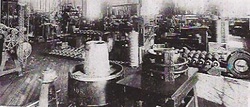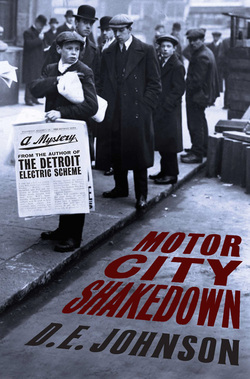|
“Detroit—Where Life’s Worth Living” (Part 2)
The People of Detroit In 1915, the Detroit Convention and Tourists' Bureau put out a lovely brochure touting the many highlights of the city. At the time, Detroit was the seventh-largest city in the country. The population was estimated at 645,000, up from 465,000 in 1910. (A 39% increase in 5 years!) As a point of comparison, the 2010 census puts Detroit at 713,000 today--a 25% decrease from 2000 and the lowest number of any official census since 1910. In 1915 Detroit:
The southern migration had begun with Ford’s “Five-dollar day” in 1914. (Up to this point, most unskilled laborers made a little over a dollar a day.) The five-dollar day sparked the growth of the middle-class, creating for the first time a large group of people who could afford to buy cars and eventually move out of the city centers where they worked. In that way, Ford first was responsible for a large part of Detroit’s growth and then for the decline of the city as those who could afford to leave did.
0 Comments
"Detroit--Where Life is Worth Living"
I've been perusing the Detroit Convention and Tourists' Bureau's 1915 brochure. They used the above slogan for the city, which was taken from this poem: IN DETROIT by Edgar A. Guest, Poet Laureate of Detroit In Detroit, life's worth living. Every day; In Detroit, we are giving, Joys away, In Detroit, it is true, That our skies are always blue, There's a smile for me and you, Blithe and gay. In Detroit, life is cheerful, All the while, For our people soothe the tearful, With a smile, We've a helping hand to lend, To a stranger, foe or friend, And our resting time we spend, On Belle Isle. In Detroit, we have pleasures By the score; And the rarest of our treasures, Yes, and more, Is our river, Oh! so bright, Cool and restful, day and night, Source of infinite delight, O'er and o'er. In Detroit, life's worth living, Every day; Folks are gentle and forgiving, If you stray, In Detroit may I be, When God's angel beckons me, O'er the silent unknown sea, Far away. I've spent a lot of the last three years trying to imagine Detroit as it was in 1910-1913. Walking the streets, studying photos, reading about the culture, entertainment, everyday life, and commerce, I thought I could just about see it. Now I wonder. I can see the buildings and parks, the river steamers and mansions, but I don't think I can feel what the city was like back then. I don't know that any city in the twenty-first century could have the power and vibrancy of Detroit a hundred years ago. Now, I don't think people have changed much, and the have-nots always outnumbered the haves by a gigantic margin, but I think even they had a hope that is not evident in the city today, except in a few individuals who believe Detroit can rise again. My hat is off to those folks (who include my daughter Nicole). In future posts I'll share some of the interesting info in the 1915 brochure, which is what I had intended to do with this post until I read "In Detroit." Will anyone--ever again--look at Detroit as Eddie Guest did once upon a time? Killed in the press  The Detroit Electric Machining Room circa 1910 I had no idea how often something like the scene at the beginning of The Detroit Electric Scheme happened in real life. (Not the murder part, just the press "accident" part). Two men at one talk this winter told me about their experiences, one at a Chrysler plant, the other at a Buick plant. One of the men had to clean out the press after a repairman had been working on the press from the inside and it stamped him. He was completely pulverized. Nothing left but liquids. The other knew a machine operator who had been leaning inside the press and put his hands up on the side of it to lever himself out. His head was still inside when one of his hands hit the switch. Last night at the Cromaine Public Library, one of the men in attendance said he used to work at Fisher Body, and he told me about the evolution of these press accidents and the attempted solutions by management. He had to clean up after one man was crushed in a press and paid close attention to it from then on. Initially there was one man at the control (single switch) while four other men would put the metal in the press, align it, and remove it when it had been stamped. When the man at the switch got distracted or hit the button accidentally , any of the four could lose a hand, arm, or head, depending on what they had in the machine at the time. They went to a two switch system, so the button couldn't be pushed accidentally, but they still had the problem with the distracted operator. Also, machine operators for whom pushing two buttons was too much effort would push in one button and wedge it in place with a toothpick, so he'd just have to push one button to start the press. Additionally, men were losing legs because they would put their leg up to stretch at just the wrong time. Next came all four men having to stand on certain spots or all hold onto a bar outside the press in order for it to work. In the meantime, hundreds (thousands?) of men were maimed or killed by these machines. Think of the outcry today if something like that was happening (in this country. I'm sure there are similar problems in sweatshops around the world, but we don't hear about those.) Life was cheap in the U.S. in those days, particularly when the men were easily replaceable and there wouldn't be publicity problems for the company. It was just the cost of doing business. Of course, the families of those men wouldn't feel the same way. Coming September 13th!  Book 2 in the Will Anderson series features Will and Elizabeth facing off with some of Detroit's early mobsters - the gangs of Vito Adamo and Tony Gianolla. My favorite character in the book is Izzy Bernstein, the youngest of the brothers who eventually ran the Purple Gang. In the book he's a newsboy who I can see in this character at the left. (And I appreciate that he's holding up an ad for my book!) My Izzy is a foul-mouthed little tough guy trying to keep up with his older - and tougher - brothers. I have no doubt it was a difficult task. The gang is thought to have been responsible for as many as 500 murders. (That's probably hyperbole, but they were definitely bad dudes.) Izzy, however, was the least criminally-inclined of the Bernsteins and spent much of his life in the "legit" world. |
AuthorD.E. Johnson: Archives
August 2016
Categories
All
|
 RSS Feed
RSS Feed